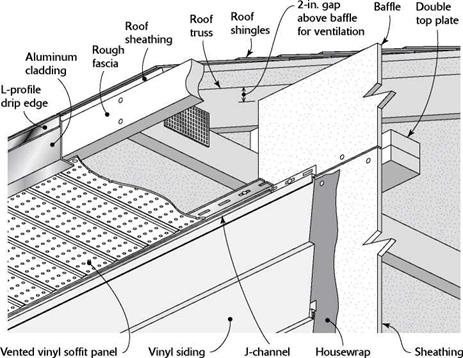Vinyl Siding
It’s not difficult to understand the popularity of vinyl siding. It’s affordable, widely available, fairly easy to install, and maintenance-free.
A drawback is that it takes time to learn how to install the vinyl trim pieces that go around doors, windows, and under eaves. Another disadvantage is that in some areas, like the Northwest, vinyl siding needs to be pressure washed yearly to remove fungal growth.
Vinyl windows, vents, soffit material, and other components are designed to be compatible with vinyl siding, and there are plenty of
colors, surface textures, and styles from which to choose. You’ll find vinyl siding on compact, affordable houses like the one featured in this book, as well as on expensive custom – built homes.
Horizontal siding is the most popular type of vinyl siding, and most styles are designed to look like wood clapboards. Clapboard widths range from 4 in. to 8 in. Manufacturers offer most of their siding with either a smooth surface or a textured, wood-grain finish. When choosing a siding color, bear in mind that it will fade slightly over time. Also, darker siding will absorb more heat and expand more than light – colored vinyl.
To estimate how much siding you’ll need, refer to the sidebar on p. 154. Keep in mind that when you buy vinyl siding, you’re actually buying a comprehensive system of siding components: siding panels, J-channel, inside and outside corner pieces, and other types of trim designed to simplify the installation and enhance the appearance. Siding manufacturers also make compatible vinyl soffit paneling and
GABLE WALL
![]()
![]()
![]()
![]()

![]()



![]()
 Be careful with delicate sheathing. Take aim carefully when installing foam sheathing. A misdirected hammer blow can easily dent or puncture the foam. Install these insulating panels with broad-head roofing nails or plastic – cap nails. Space the nails about 16 in. apart along the edges and 24 in. apart everywhere else.
Be careful with delicate sheathing. Take aim carefully when installing foam sheathing. A misdirected hammer blow can easily dent or puncture the foam. Install these insulating panels with broad-head roofing nails or plastic – cap nails. Space the nails about 16 in. apart along the edges and 24 in. apart everywhere else.






Leave a reply